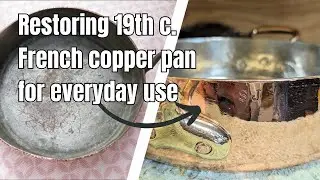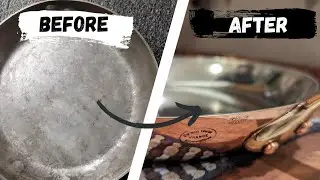Full retinning, 12" vintage French copper stockpot
Wiped tin is the traditional lining for copper cookware because it provides a naturally anti-stick, nonreactive, nontoxic cooking surface that, if applied thick and cleaned without abrasives, typically holds up to 10-20+ years of regular cooking before it needs retinning again. The pan can be restored more or less eternally this way, making tinned copper the longest-lasting, most sustainable style of cookware.
Quality copper pans are pricey, but they can permanently replace your nonstick-coated cookware; and the lifetime cost of ownership with retinning as needed can easily be lower than replacing most "ceramic" nonstick pans when the coating fails every couple years, or Teflon coated pans when they fail every 3-5 years. Copper pans will never end up in a landfill like nonstick coated ones inevitably do.
Retinning starts at $70. Most normal home sizes cost around $80-100 ($7/linear inch, calculated as the diameter plus twice height). This comes with deep cleaning, buffing the exterior, minor repairs if needed -- correcting any warping, dents, out of round to restore original function, tightening loose rivets/handles. The only repairs that cost extra are cracks/holes, which must be brazed, $60-100 depending on severity.
The prominent, well-defined wiped texture throughout the new tin is intentional and important -- this shows the tin was applied maximally thick, and will be much more durable than tin that was wiped smooth without the consistent wipe marks. The brushstroke-like texture is the traditional French technique you get from high-end makes such as Mauviel and Mazzetti as well as retinning services with the highest standards. Wiping the tin perfectly smooth is much easier and uses less material, but may only last half as long with normal use.
Pitting and utensil marks inside the pans are in the underlying copper, and show through because tin isn't a self-leveling coating. I don't remove these because they don't affect tin's anti-stick performance / ease of cleaning, and sanding them out would needlessly thin the pan, shortening its working life. Tin's anti-stick property is because it's smoother on a microscopic level (tighter grain structure at the surface) than the other cookware metals, lacking the "pores" or tiny crevices that food molecules (proteins, starches etc) over heat tend to catch in, scorch and bond with the metal. Visible peaks and valleys are too big to matter to these microscopic particles. Also in interest of conservation, I don't sand or grind the exterior before polishing or use any heavy/primary cutting wheels, so deep scratches, nicks, crisp hammer marks, etc all remain. The wear from use is considered the copper's patina; part of what makes using vintage and antique copper pans special is their working history is reflected in the surface texture.
The set in this video belong to a metro Detroit chef, and are stamped "Kitchen Glamor Detroit Made in France," for a Detroit kitchenware chain that operated from 1950 to the 1990s. The stockpot, skillet and saucepans were made by Lefevre of Villedieu, and the sautes were made by Mauviel, all most likely 1960s-70s. The other stamp "J S" is for the owner's initials, this traditional owner's mark costs $20 extra with retinning, or free on purchases from me.
To shop restored vintage and antique high-end French copper cookware, or get your old copper pan put back in working order:
https://northcoastcopper.etsy.com
For more info on using and restoring traditional copper cookware, or to contact me with any questions:
/ northcoastcopper
/ northcoastcopper
/ northcoastcopper
https://www.x.com/@northcoastcopper
[email protected]





![[水彩スケッチは、ためらわず素早く描くとイキイキ感が出る] 勢いのあるストローク 水彩メイキング Masato Watanabe](https://images.videosashka.com/watch/RVF5X8tXA1E)







